Mechanical Analysis for Active Movement of Upper Limb Rehabilitation Robots to Alleviate Shoulder Pain in Patients with Stroke Hemiplegia and Frozen Shoulder
Abstract
1. Introduction
2. Method
2.1. Scapulohumeral Rhythm
2.2. Usability Evaluation
2.2.1. Selection of Subjects
2.2.2. Selection of Subjects and Ethical Considerations
2.2.3. Experimental Equipment and Motion Protocol
2.2.4. Data Collection and Processing
2.3. Kinematic Analysis Verification for Active Assisted Mode
2.3.1. Robot Coordinate System Analysis
2.3.2. Regular Geometry Calculation
2.3.3. Verification of Regular Kinematics Through Inverse Kinematics
3. Result
- -
- The X-coordinate exhibited a decreasing trend with a negative slope across most segments, with notable deviations observed in Links 2 and 3.
- -
- The Y-coordinate showed a nearly linear decrease as the rotation angle increased, suggesting a close relationship with the motion of the rotational center.
- -
- The Z-coordinate exhibited only minor changes across all segments, indicating that the robot structure was primarily designed for planar motion.
4. Discussion
5. Conclusions
Author Contributions
Funding
Institutional Review Board Statement
Informed Consent Statement
Data Availability Statement
Conflicts of Interest
References
- Jung, J.; Shon, M.S. Epidemiology and etiology of shoulder pain based on health statistics data from Healthcare Bigdata Hub in Korea. J. Korean Med. Assoc./Taehan Uisa Hyophoe Chi 2022, 65, 687–698. [Google Scholar] [CrossRef]
- Seo, B. Shoulder Pain Rising in 30s and 40s Due to Sedentary Lifestyle. J. Health Media 2024. Available online: https://jhealthmedia.joins.com/news/articleView.html?idxno=29575 (accessed on 24 January 2025).
- Hiraga, Y.; Hayashi, T. Mediating effect of upper limb use on the relationship between upper limb performance and activities of daily living: A longitudinal mediation analysis. Cureus 2022, 14, e30849. [Google Scholar] [CrossRef] [PubMed]
- Le, H.V.; Lee, S.J.; Nazarian, A.; Rodriguez, E.K. Adhesive capsulitis of the shoulder: Review of pathophysiology and current clinical treatments. Shoulder Elb. 2017, 9, 75–84. [Google Scholar] [CrossRef] [PubMed]
- Beare, B.; Brander, F.; Farrell, R.; Lakra, C.; Higgins, R.; Ward, N. Understanding frozen shoulder in the hemiparetic arm after stroke. Adv. Clin. Neurosci. Rehabil. 2023, 22, 12–15. [Google Scholar] [CrossRef]
- Suethanapornkul, S.; Kuptniratsaikul, P.S.A.; Kuptniratsaikul, V.; Uthensut, P.; Dajpratha, P.; Wongwisethkarn, J. Post stroke shoulder subluxation and shoulder pain: A cohort multicenter study. J. Med. Assoc. Thai 2008, 91, 1885–1892. [Google Scholar] [PubMed]
- Fernandes, J.B.; Vareta, D.; Fernandes, S.; Almeida, A.S.; Peças, D.; Ferreira, N.; Roldão, L. Rehabilitation workforce challenges to implement person-centered care. Int. J. Environ. Res. Public Health 2022, 19, 3199. [Google Scholar] [CrossRef] [PubMed]
- Qassim, H.M.; Wan Hasan, W.Z. A review on upper limb rehabilitation robots. Appl. Sci. 2020, 10, 6976. [Google Scholar] [CrossRef]
- Banyai, A.D.; Brișan, C. Robotics in physical rehabilitation: Systematic review. Healthcare 2024, 12, 1720. [Google Scholar] [CrossRef] [PubMed] [PubMed Central]
- Rodgers, H.; Bosomworth, H.; Krebs, H.I.; van Wijck, F.; Shaw, L.; Agler, M.; Alvarado, N.; Andole, S.; Cohen, D.L.; Dawson, J.; et al. Robot-assisted training for the upper limb after stroke (RATULS): A multicentre randomised controlled trial. Lancet 2019, 394, 51–62. [Google Scholar] [CrossRef] [PubMed]
- Tyromotion GmbH. DIEGO®: Robotics-Assisted Arm–Shoulder Rehabilitation System with Intelligent Gravity Compensation and VR-Based Gam-ification. Product Factsheet. Tyromotion, n.d. Available online: https://tyromotion.com/wp-content/uploads/2018/12/20_09-Factsheet.DIEGO_en_screen.pdf (accessed on 20 December 2018).
- Takebayashi, T.; Takahashi, K.; Amano, S.; Koyama, T.; Marumoto, K.; Nagaoka, M.; Domen, K. Assessment of the efficacy of ReoGo-J robotic training for upper limb function in patients with chronic stroke: A randomized controlled trial. J. Stroke Cerebrovasc. Dis. 2018, 27, 3064–3070. [Google Scholar]
- Brauchle, D.; Gharabaghi, A.; Ramos-Murguialday, A. Brain state-dependent robotic reaching movement with a commercially available exoskeleton (ArmeoPower, Hocoma, Schweiz) in stroke survivors. Front. Hum. Neurosci. 2015, 9, 564. [Google Scholar]
- Ren, Y.; Kang, S.H.; Park, H.S.; Wu, Y.N.; Zhang, L.Q. Developing a multi-joint upper limb exoskeleton robot for diagnosis, therapy, and outcome evaluation in neurorehabilitation. IEEE Trans. Neural Syst. Rehabil. Eng. 2013, 21, 490–499. [Google Scholar] [CrossRef] [PubMed]
- Xiloyannis, M.; Alicea, R.; Georgarakis, A.M.; Haufe, F.L.; Wolf, P.; Masia, L.; Riener, R. Soft robotic suits: State of the art, core technologies, and open challenges. IEEE Trans. Robot. 2022, 38, 1343–1362. [Google Scholar] [CrossRef]
- Romero-Sánchez, F.; Luporini Menegaldo, L.L.; Font-Llagunes, J.M.; Sartori, M. Editorial: Rehabilitation robotics: Challenges in design, control, and real applications. Front. Neurorobot. 2022, 16, 957905. [Google Scholar] [CrossRef] [PubMed]
- Lee, J.S.; Kim, T.H.; Cho, S.M.; Kim, K.G. Development of a rehabilitation robot for shoulder pain treatment. J. Rehabil. Eng. 2022, 16, 237–244. [Google Scholar]
- Hwang, D.; Shin, J.-H.; Kwon, S. Kinematic assessment to measure change in impairment during active and active-assisted type of robotic rehabilitation for patients with stroke. Sensors 2021, 21, 7055. [Google Scholar] [CrossRef] [PubMed]
- Pascoal, A.G.; Ribeiro, A.; Infante, J. Scapular Resting Posture and Scapulohumeral Rhythm Adaptations in Volleyball Players: Implications for Clinical Shoulder Assessment in Athletes. Sports 2023, 11, 114. [Google Scholar] [CrossRef] [PubMed]
- Wang, J.; Pei, S.; Guo, J.; Dong, A.; Sun, L.; Shang, H.; Yao, Y. Inverse Kinematics Framework for an Upper Limb Exoskeleton with a Shoulder Girdle Mechanism Using Vector Methods. SSRN. Available online: https://ssrn.com/abstract=4958416 (accessed on 17 September 2024). [CrossRef]
- Ning, Y.; Sang, L.; Wang, H.; Wang, Q.; Vladareanu, L.; Niu, J. Upper limb exoskeleton rehabilitation robot inverse kinematics modeling and solution method based on multi-objective optimization. Sci. Rep. 2024, 14, 25476. [Google Scholar] [CrossRef] [PubMed]
- Scibek, J.S.; Carcia, C.R. Assessment of scapulohumeral rhythm for scapular plane shoulder elevation using a modified digital inclinometer. J. Sport Rehabil. 2012, 21, 227–235. [Google Scholar] [CrossRef] [PubMed]
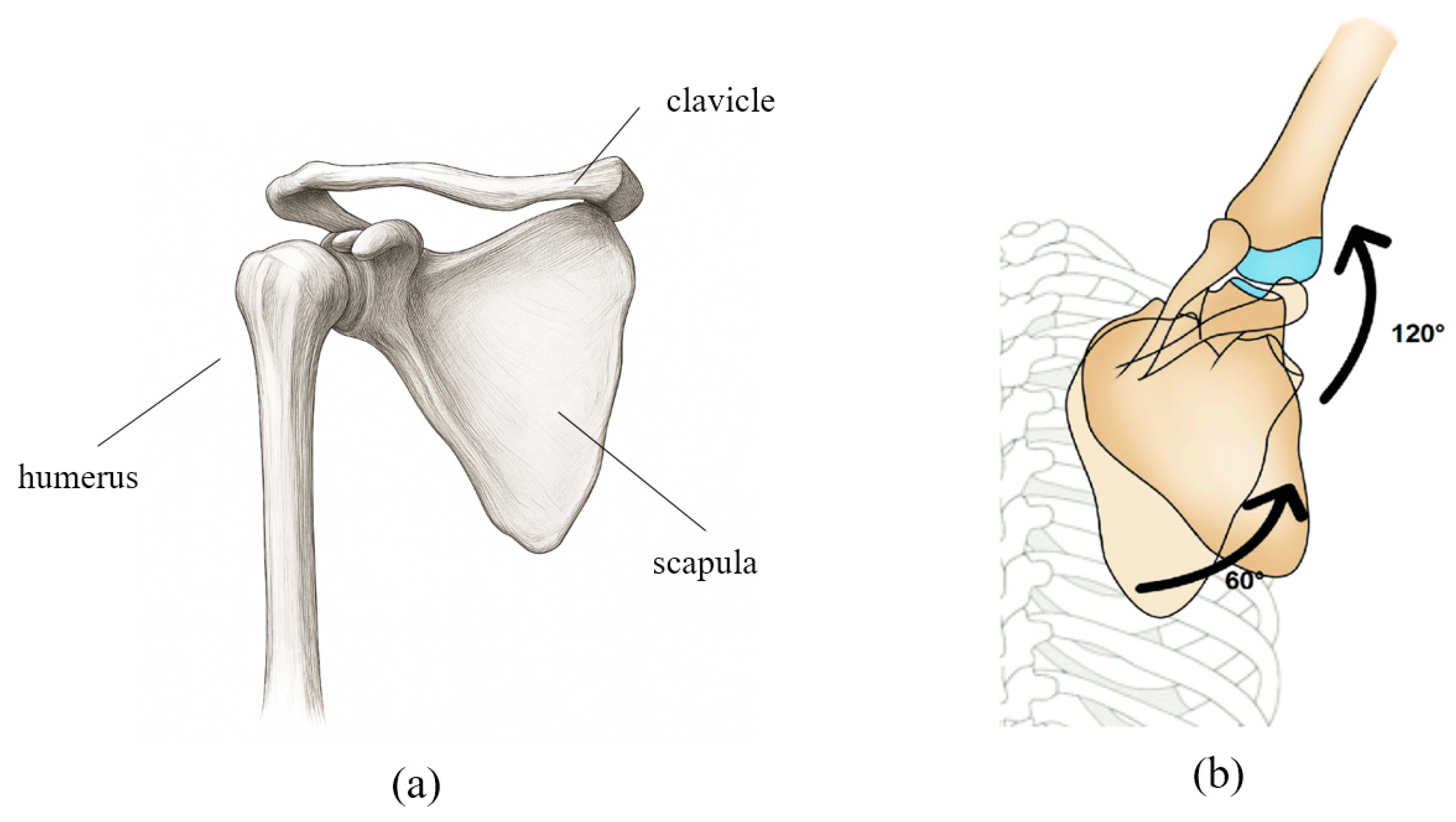
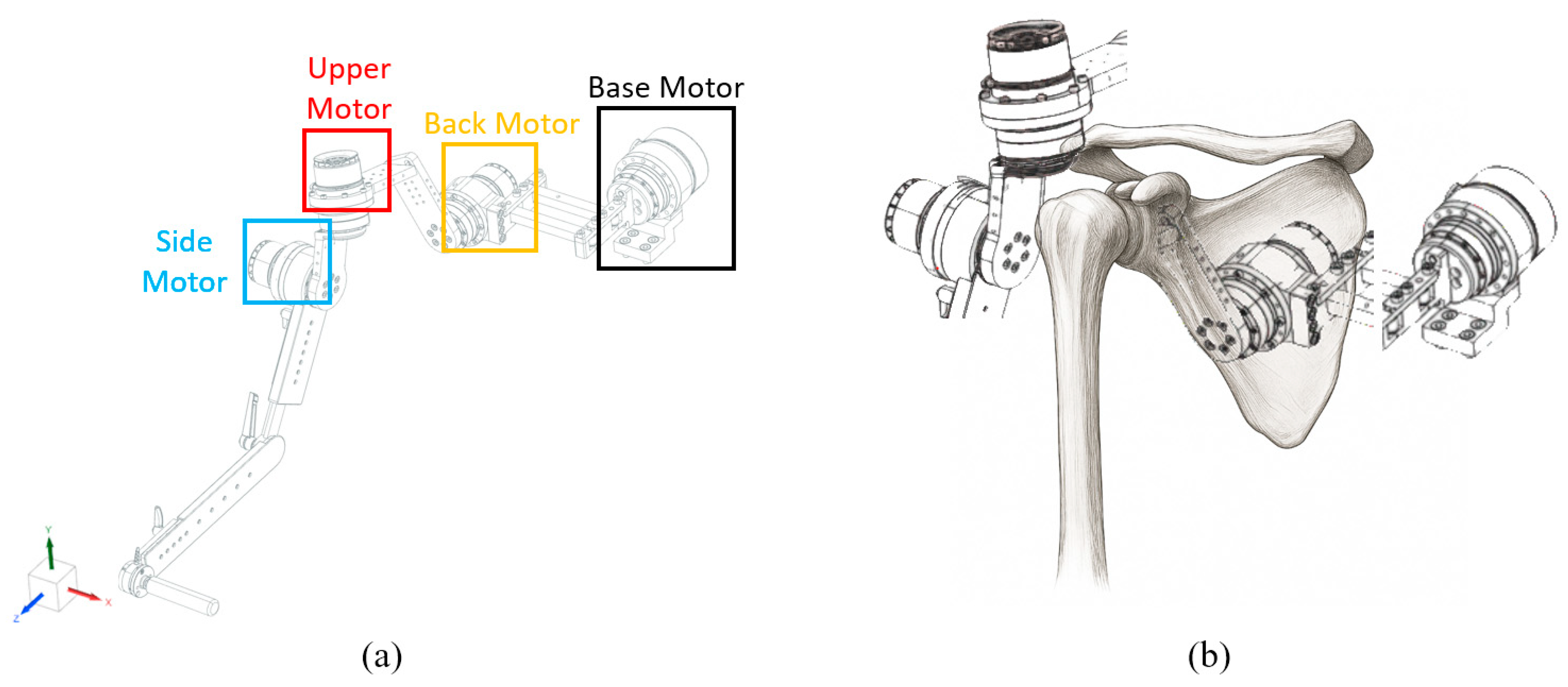
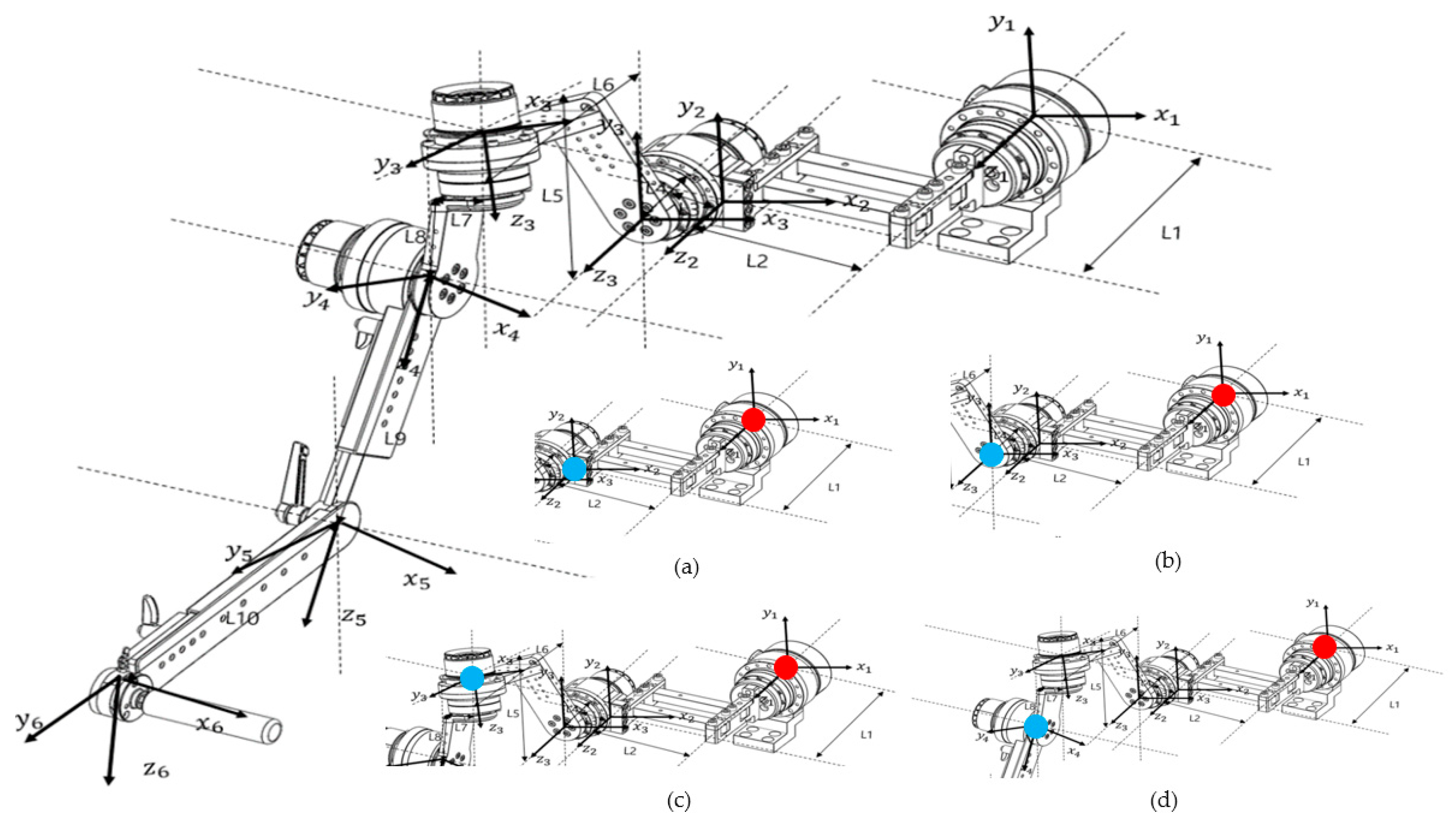

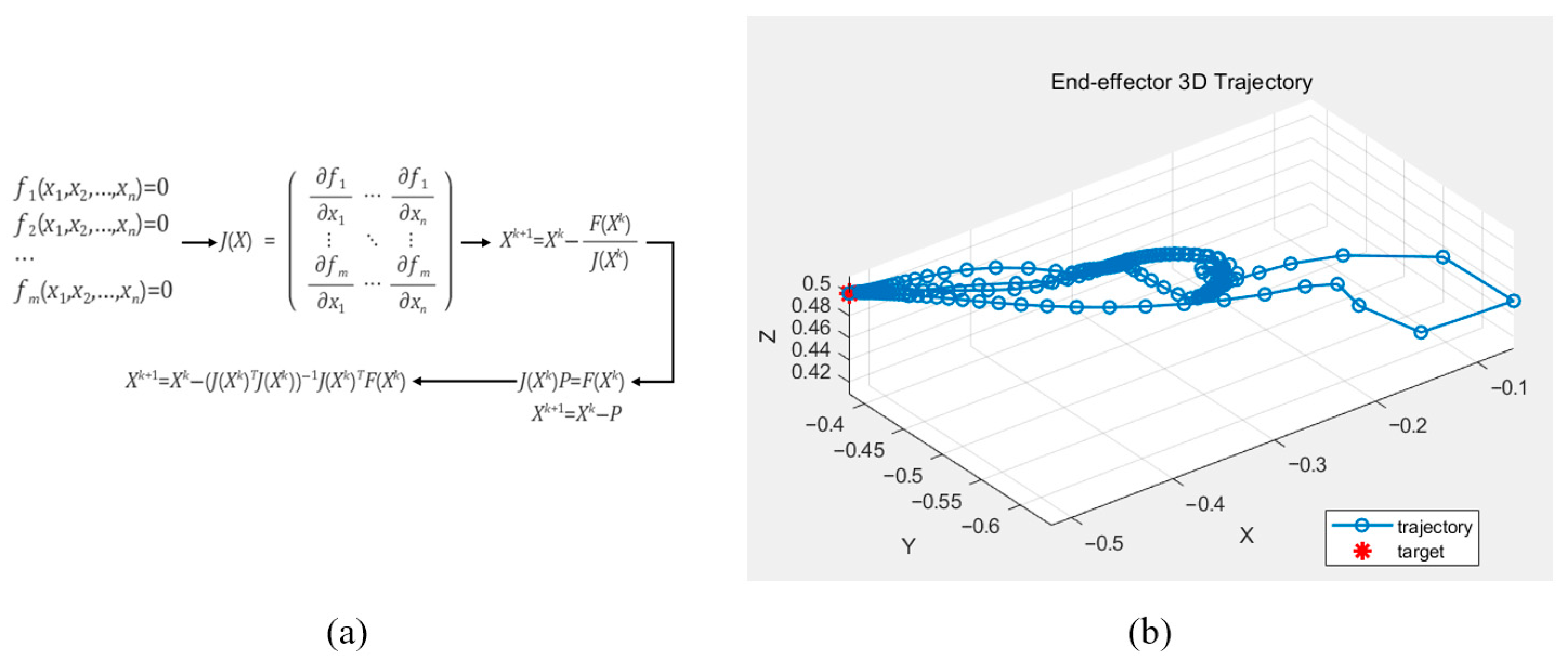
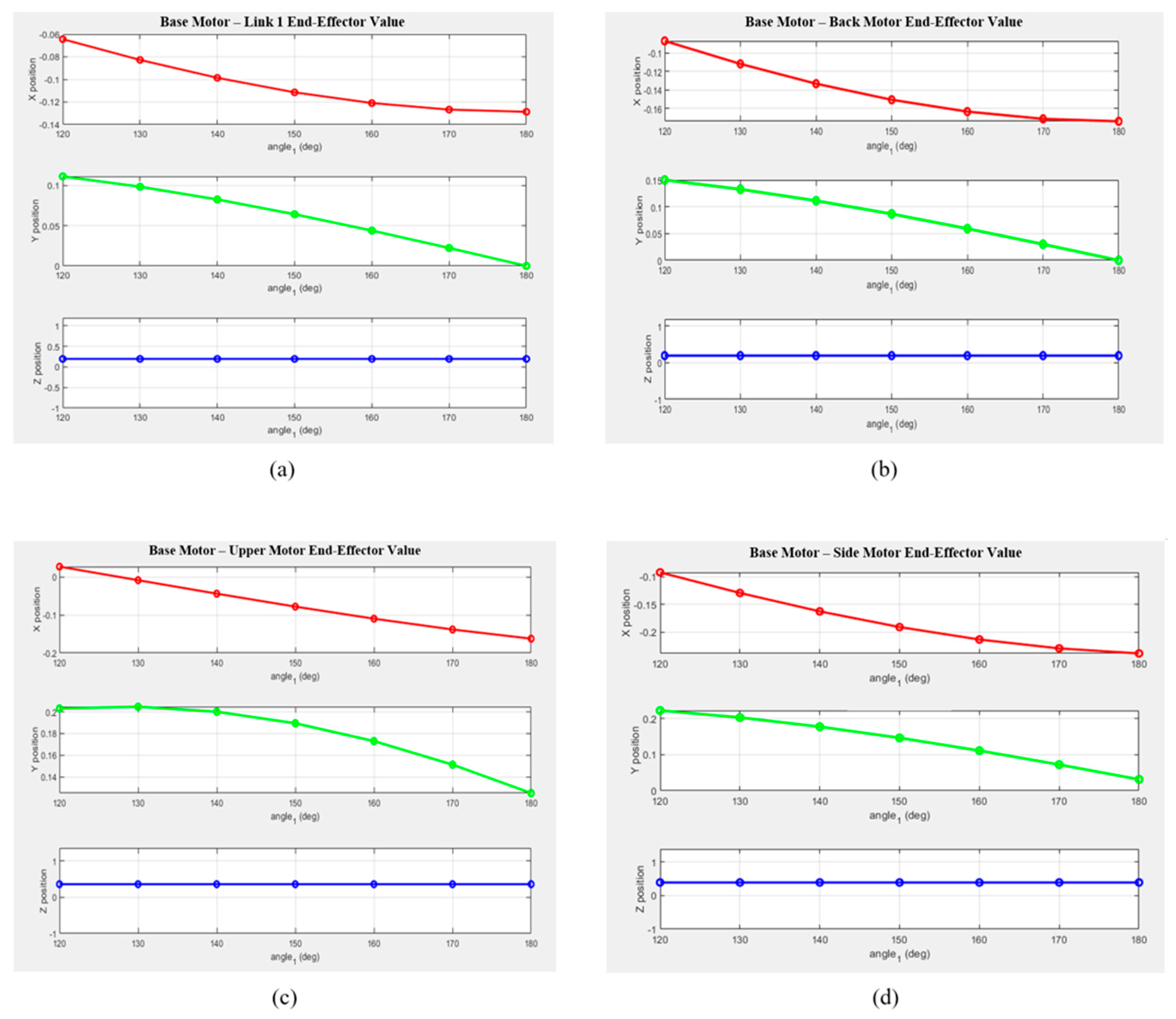
| Section | Maximum Error Rate (%) | Maximum Error (cm) | Main Causes of Errors |
|---|---|---|---|
| Base Motor–Link1 | 0.6% | 0.08 | Numerical differences between simulation and MATLAB |
| Base Motor–Back Motor | 2.8% | 0.49 | Error in changing formulas on the same line |
| Base Motor–Upper Motor | 0.5% | 0.08 | Multi-axis rotation |
| Base Motor–Side Motor | 0.5% | 0.22 | Multi-axis rotation |
| Base Motor -> link2 | MATLAB | SolidWorks | Result | MATLAB | SolidWorks | Result | MATLAB | SolidWorks | Result |
| Degree | 10 | 10 | 20 | 20 | 30 | 30 | |||
| x | −12.68 | −12.67 | 0.01 | −12.1 | −12.09 | 0.01 | −11.15 | −11.17 | 0.02 |
| y | 2.23 | 2.17 | 0.06 | 4.33 | 4.4 | 0.07 | 6.43 | 6.35 | 0.08 |
| z | 19.55 | 19.55 | 0 | 19.56 | 19.55 | −0.01 | 19.56 | 19.55 | −0.01 |
| Base Motor -> Back Motor | MATLAB | SolidWorks | Result | MATLAB | SolidWorks | Result | MATLAB | SolidWorks | Result |
| Degree | 10 | 10 | 20 | 20 | 30 | 30 | |||
| x | −17.11 | −16.62 | 0.49 | −16.32 | −15.87 | 0.45 | −15.04 | −14.64 | 0.4 |
| y | 3.02 | 2.86 | 0.16 | 5.94 | 5.69 | 0.25 | 8.68 | 8.35 | 0.33 |
| z | 19.55 | 19.44 | 0.11 | 19.55 | 19.44 | 0.11 | 19.55 | 19.45 | 0.1 |
| Base Motor -> Upper Motor | MATLAB | SolidWorks | Result | MATLAB | SolidWorks | Result | MATLAB | SolidWorks | Result |
| Degree | 10 | 10 | 20 | 20 | 30 | 30 | |||
| x | −13.81 | −13.89 | 0.08 | −10.97 | −11.05 | 0.08 | −7.8 | −7.88 | 0.08 |
| y | 15.13 | 15.12 | 0.01 | 17.3 | 17.28 | 0.02 | 18.94 | 18.92 | 0.02 |
| z | 36.23 | 36.24 | 0.01 | 36.23 | 36.25 | 0.02 | 36.23 | 36.27 | 0.04 |
| Base Motor -> Side Motor | MATLAB | SolidWorks | Result | MATLAB | SolidWorks | Result | MATLAB | SolidWorks | Result |
| Degree | 10 | 10 | 20 | 20 | 30 | 30 | |||
| x | −22.9 | −22.84 | 0.07 | −21.3 | 21.24 | 0.06 | −19.06 | −19 | 0.06 |
| y | 7.22 | 7.19 | 0.03 | 11.09 | 11.02 | 0.07 | 14.62 | 14.52 | 0.1 |
| z | 39.36 | 39.14 | 0.22 | 39.36 | 39.15 | 0.21 | 39.36 | 39.16 | 0.2 |
| Base Motor -> link2 | MATLAB | SolidWorks | Result | MATLAB | SolidWorks | Result | MATLAB | SolidWorks | Result |
| Degree | 40 | 40 | 50 | 50 | 60 | 60 | |||
| x | −9.89 | −9.85 | 0.03 | −8.32 | −8.27 | 0.05 | −6.49 | −6.43 | 0.06 |
| y | 8.18 | 8.27 | 0.09 | 9.76 | 9.85 | 0.1 | 11.05 | 11.15 | 0.1 |
| z | 19.57 | 19.55 | −0.02 | 19.58 | 19.55 | −0.03 | 19.58 | 19.55 | −0.03 |
| Base Motor -> Back Motor | MATLAB | SolidWorks | Result | MATLAB | SolidWorks | Result | MATLAB | SolidWorks | Result |
| Degree | 40 | 40 | 50 | 50 | 60 | 60 | |||
| x | −13.31 | −12.96 | 0.35 | −11.17 | −10.89 | 0.28 | −8.68 | −8.5 | 0.18 |
| y | 11.17 | 10.75 | 0.42 | 13.31 | 12.82 | 0.49 | 15.04 | 14.51 | 0.53 |
| z | 19.55 | 19.46 | 0.09 | 19.55 | 19.47 | 0.08 | 19.55 | 19.48 | 0.07 |
| Base Motor -> Upper Motor | MATLAB | SolidWorks | Result | MATLAB | SolidWorks | Result | MATLAB | SolidWorks | Result |
| Degree | 40 | 40 | 50 | 50 | 60 | 60 | |||
| x | −4.4 | −4.47 | 0.07 | −0.85 | −0.93 | 0.08 | 2.71 | 2.63 | 0.08 |
| y | 20.01 | 19.98 | 0.03 | 20.47 | 20.43 | 0.04 | 20.31 | 20.25 | 0.06 |
| z | 36.23 | 36.28 | 0.05 | 36.23 | 36.23 | 0 | 36.23 | 36.31 | 0.08 |
| Base Motor -> Side Motor | MATLAB | SolidWorks | Result | MATLAB | SolidWorks | Result | MATLAB | SolidWorks | Result |
| Degree | 40 | 40 | 50 | 50 | 60 | 60 | |||
| x | −16.23 | −16.19 | 0.04 | −12.91 | −12.88 | 0.03 | −9.19 | −9.2 | 0.01 |
| y | 17.7 | 17.58 | 0.12 | 20.25 | 20.09 | 0.16 | 22.19 | 22 | 0.19 |
| z | 39.36 | 39.17 | 0.19 | 39.36 | 39.19 | 0.17 | 39.36 | 39.2 | 0.16 |
Disclaimer/Publisher’s Note: The statements, opinions and data contained in all publications are solely those of the individual author(s) and contributor(s) and not of MDPI and/or the editor(s). MDPI and/or the editor(s) disclaim responsibility for any injury to people or property resulting from any ideas, methods, instructions or products referred to in the content. |
© 2025 by the authors. Licensee MDPI, Basel, Switzerland. This article is an open access article distributed under the terms and conditions of the Creative Commons Attribution (CC BY) license (https://creativecommons.org/licenses/by/4.0/).
Share and Cite
Bang, S.J.; Lee, J.-S.; Song, D.H.; Ryu, S.Y.; Kim, K.G. Mechanical Analysis for Active Movement of Upper Limb Rehabilitation Robots to Alleviate Shoulder Pain in Patients with Stroke Hemiplegia and Frozen Shoulder. Sensors 2025, 25, 6644. https://doi.org/10.3390/s25216644
Bang SJ, Lee J-S, Song DH, Ryu SY, Kim KG. Mechanical Analysis for Active Movement of Upper Limb Rehabilitation Robots to Alleviate Shoulder Pain in Patients with Stroke Hemiplegia and Frozen Shoulder. Sensors. 2025; 25(21):6644. https://doi.org/10.3390/s25216644
Chicago/Turabian StyleBang, Seok Jin, Jung-Soo Lee, Dong Hyeon Song, Seung Yeob Ryu, and Kwang Gi Kim. 2025. "Mechanical Analysis for Active Movement of Upper Limb Rehabilitation Robots to Alleviate Shoulder Pain in Patients with Stroke Hemiplegia and Frozen Shoulder" Sensors 25, no. 21: 6644. https://doi.org/10.3390/s25216644
APA StyleBang, S. J., Lee, J.-S., Song, D. H., Ryu, S. Y., & Kim, K. G. (2025). Mechanical Analysis for Active Movement of Upper Limb Rehabilitation Robots to Alleviate Shoulder Pain in Patients with Stroke Hemiplegia and Frozen Shoulder. Sensors, 25(21), 6644. https://doi.org/10.3390/s25216644







